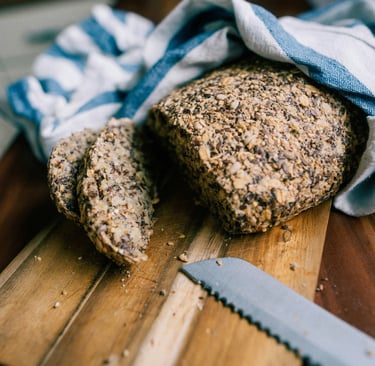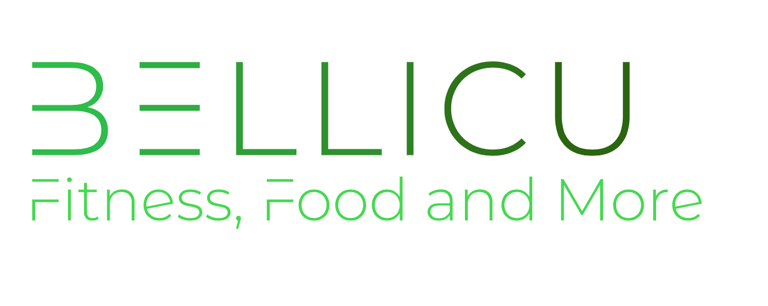
DASH Diet
(Dietary Approaches to Stop Hypertension)
A Natural Path to Lower Blood Pressure
Hypertension—commonly known as high blood pressure—affects millions of adults around the world and is one of the leading risk factors for heart attack, stroke, kidney failure, and even cognitive decline. What makes it especially dangerous is that it often develops without noticeable symptoms, earning it the nickname “the silent killer.” You may feel perfectly fine while damage is quietly accumulating in your arteries, heart, and organs.
While medication is a common treatment, there's growing recognition that lifestyle changes—particularly dietary ones—can be just as powerful, if not more so, in controlling blood pressure. That’s where the DASH diet comes in.
In a world saturated with extreme dieting trends and miracle cures, DASH stands out for one simple reason: it works. Developed through years of rigorous scientific research, the DASH eating plan has become a gold standard in nutritional therapy for hypertension. But what makes it so effective isn’t just its nutrient profile—it’s the fact that it’s realistic, sustainable, and designed to work in real life, not just on paper.
This guide breaks down everything you need to know about using the DASH diet for high blood pressure, including how it works, what to eat (and avoid), and how to make the transition without stress or sacrifice. Whether you’re already managing hypertension or want to get ahead of it, the DASH diet offers a science-backed path to better heart health—one delicious, balanced meal at a time.
What Is the DASH Diet?
The DASH diet, which stands for Dietary Approaches to Stop Hypertension, was created by the National Institutes of Health (NIH) as part of a groundbreaking clinical study to explore the effects of nutrition on blood pressure. Unlike trendy or restrictive diets, DASH isn’t about quick fixes or dramatic weight loss promises. Instead, it’s a sustainable eating plan rooted in decades of medical research, designed to improve heart health and reduce hypertension through everyday food choices.
At its core, the DASH diet promotes a well-rounded, nutrient-rich approach to eating that helps balance the body’s sodium levels while supplying essential minerals that support healthy blood pressure—specifically potassium, magnesium, and calcium. It focuses on whole foods that are minimally processed and naturally low in sodium.
What the DASH Diet Emphasizes:
Fruits and vegetables – Rich in fiber, antioxidants, and blood-pressure-lowering potassium
Whole grains – Oats, quinoa, brown rice, and whole wheat provide long-lasting energy and support heart health
Lean proteins – Skinless poultry, fish, legumes, and occasional lean red meat for muscle maintenance and satiety
Low-fat or fat-free dairy – Provides calcium and protein without the added saturated fat
Nuts, seeds, and legumes – Healthy sources of fat and plant-based protein, also rich in magnesium and fiber
What It Recommends Reducing:
Sodium – Especially from processed foods and salty snacks, since sodium can raise blood pressure
Saturated fat and cholesterol – Common in fried foods, full-fat dairy, and fatty meats, these can harm cardiovascular health
Added sugars – Often found in sweetened beverages, baked goods, and processed snacks, contributing to weight gain and insulin resistance
This strategic combination of foods helps create a naturally heart-supportive environment in the body. The DASH diet isn’t just about lowering blood pressure—it also contributes to better weight management, reduced inflammation, improved cholesterol levels, and lower risk of developing type 2 diabetes.
Because it doesn’t require calorie counting or extreme restrictions, DASH is considered flexible, adaptable, and family-friendly, making it one of the most recommended dietary strategies by doctors and dietitians alike. Whether you’re already diagnosed with hypertension or simply aiming to optimize your long-term wellness, the DASH diet offers a realistic and powerful foundation for healthy living.
Why the DASH Diet Works for Hypertension
Hypertension doesn’t develop overnight—it’s often the result of long-term dietary habits, stress, lack of physical activity, and other lifestyle factors. The power of the DASH diet for high blood pressure lies in its ability to address the root causes of hypertension by improving nutrient intake, reducing excess sodium, and supporting healthy vascular function. Here’s how it works:
The Role of Sodium in Blood Pressure
Sodium is a necessary mineral for fluid balance and nerve function, but in excess, it becomes a major contributor to elevated blood pressure. Most people consume far more sodium than needed, primarily through processed and restaurant foods. When sodium levels in the body rise, it causes water retention. This extra fluid increases blood volume, placing more pressure on blood vessel walls—resulting in higher blood pressure.
The DASH diet specifically targets this issue by encouraging a significant reduction in sodium intake. Two versions of the diet exist, depending on your current health status and goals:
Standard DASH: Recommends limiting sodium to 2,300 mg per day, which aligns with general dietary guidelines.
Lower Sodium DASH: Further restricts sodium to 1,500 mg per day, a level shown to produce even greater reductions in blood pressure—especially beneficial for individuals already diagnosed with hypertension or at high risk.
By replacing salty processed foods with fresh, whole ingredients, the DASH diet helps reduce water retention and improve vascular function naturally—without the side effects of medication.
Potassium, Magnesium, and Calcium – The Triple Mineral Advantage
While lowering sodium is essential, it’s only half the picture. The DASH diet also emphasizes foods that are rich in potassium, magnesium, and calcium, three minerals that work together to maintain healthy blood pressure:
Potassium helps counteract the effects of sodium by promoting sodium excretion through urine. It also relaxes blood vessel walls, lowering resistance and easing pressure.
Magnesium plays a key role in regulating vascular tone and supporting normal muscle and nerve function—including the muscles in your heart and blood vessels.
Calcium is crucial for maintaining proper contraction and relaxation of blood vessels. Low calcium intake is linked to higher blood pressure, so getting enough from dairy or leafy greens is vital.
By boosting intake of these minerals through whole foods rather than supplements, the DASH diet provides a natural, balanced approach to vascular support and blood pressure regulation.
Fiber and Antioxidants – The Silent Protectors
One of the often-overlooked strengths of the DASH diet is its high content of dietary fiber and antioxidants, largely thanks to its emphasis on fruits, vegetables, legumes, and whole grains.
Fiber—particularly soluble fiber—can help lower LDL ("bad") cholesterol and improve insulin sensitivity, both of which contribute to better heart health. Fiber also supports weight management by enhancing satiety, reducing the likelihood of overeating.
Antioxidants, such as vitamin C, flavonoids, and polyphenols found in colorful plant foods, help reduce oxidative stress and inflammation—two underlying contributors to arterial damage and high blood pressure.
Together, fiber and antioxidants protect the inner lining of the arteries, improve blood flow, and reduce the risk of plaque buildup and vascular stiffness. This is one reason why the DASH diet doesn’t just manage hypertension—it actively reverses some of the damage that leads to it.
By combining these strategies—reducing sodium, increasing key minerals, and flooding the body with fiber and antioxidants—the DASH diet offers a scientifically validated, multidimensional approach to lowering blood pressure naturally. It's not just about eating differently; it's about shifting your body’s internal chemistry in favor of long-term heart health.
DASH Diet vs. Other Heart-Healthy Diets

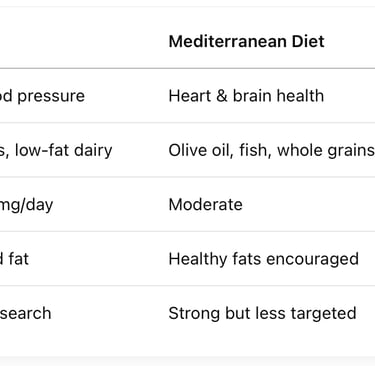
What to Eat on the DASH Diet
Recommended Foods (Daily or Weekly)
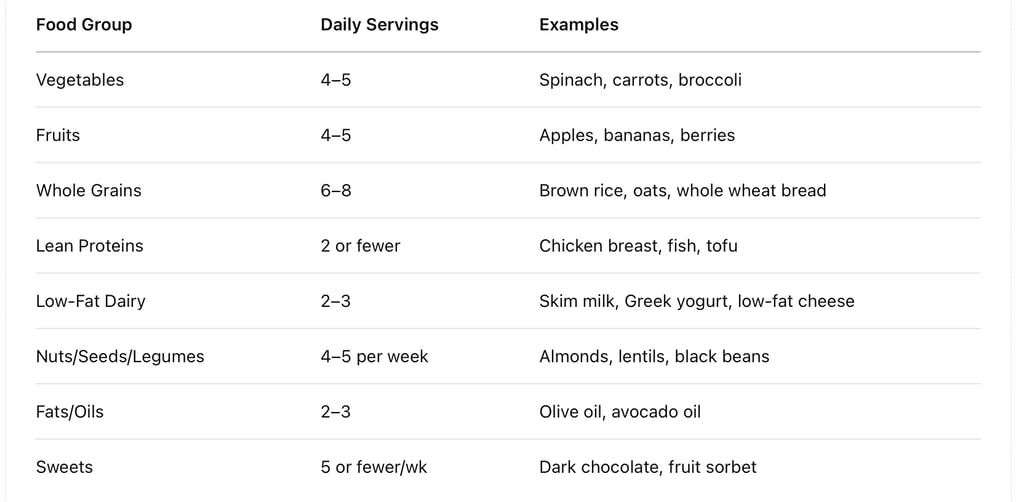

What to Avoid on the DASH Diet
High-Sodium Foods
Processed meats (bacon, ham)
Canned soups and salty snacks
Fast food and restaurant dishes
Foods High in Saturated Fat
Full-fat dairy
Fried foods
Butter, lard, and shortening
Added Sugars
Soda
Pastries
Sugary breakfast cereals
Benefits of the DASH Diet Beyond Blood Pressure
While the DASH diet was originally created to lower high blood pressure, its ripple effect on overall health is nothing short of impressive. This eating plan doesn’t just protect your heart—it supports your entire body. From waistline wins to long-term disease prevention, here’s why DASH is more than just a “blood pressure” diet.
Weight Loss Without the Obsession
If you’ve struggled with yo-yo dieting or restrictive meal plans, the DASH diet may feel like a breath of fresh air. It doesn’t demand calorie counting or cutting entire food groups. Instead, by focusing on nutrient-dense foods and limiting empty calories from sugar, processed snacks, and saturated fat, weight loss often happens naturally and gradually—no gimmicks needed.
Plus, its high fiber and protein content helps you feel full and satisfied, reducing cravings and late-night snacking. For many, switching to DASH results in steady fat loss, particularly around the midsection—a major win for both aesthetics and heart health.
Defense Against Chronic Disease
The DASH diet doesn’t just lower your blood pressure—it builds a strong defense system against many of today’s most common chronic diseases. Thanks to its anti-inflammatory, antioxidant-rich foundation, following DASH can significantly lower the risk of:
Type 2 diabetes – By improving insulin sensitivity and stabilizing blood sugar levels
Metabolic syndrome – With benefits across weight, blood pressure, and cholesterol
Heart disease – By reducing LDL cholesterol and improving vascular health
Kidney disease – By protecting renal function, especially in those with hypertension or diabetes
It's a full-body upgrade—one plate at a time.
Real-Life Friendly and Family-Approved
Let’s be honest—many “healthy” diets are difficult to stick with, especially if you’re cooking for a family. The DASH diet stands out because it’s flexible, realistic, and doesn’t ban the foods people love. You’re not cutting out carbs, fats, or having to buy expensive specialty products. Instead, you’re making simple swaps: whole grains over white bread, lean proteins over fatty cuts, herbs over salt.
It’s a plan you can share with the whole family—kids, partners, even picky eaters—without anyone feeling like they’re “on a diet.” And because it’s based on real, everyday foods, you can follow DASH at home, at work, or dining out with minimal stress.
The best part? These benefits compound over time. The longer you follow the DASH diet, the more your body—and your lifestyle—adapts to this healthier rhythm. It’s not just a diet; it’s a lifelong investment in your health, energy, and vitality.
Tips for Getting Started with the DASH Diet
Transitioning to a new way of eating doesn’t have to be overwhelming. The beauty of the DASH diet is that it’s flexible, intuitive, and easy to adapt to your current routine. Whether you’re easing into healthier choices or making a full dietary overhaul, here are some practical tips to help you get started—and stick with it.
Gradually Reduce Sodium (Not Flavor)
Most people consume far more sodium than they realize—often from processed foods, sauces, condiments, and restaurant meals. Instead of slashing salt overnight (which can feel restrictive), start by:
Choosing low-sodium versions of your go-to staples like broth, canned beans, and sauces.
Rinsing canned vegetables or legumes to remove excess sodium.
Cooking more at home, where you control the salt.
Flavoring meals with herbs, citrus, garlic, or spices like cumin, paprika, and chili flakes.
Your taste buds will adapt over time—and you won’t miss the salt nearly as much as you think.
Prioritize Whole, Fresh Ingredients
The more natural the food, the more DASH-friendly it likely is. Processed foods tend to be high in sodium, added sugars, and unhealthy fats. Focus on:
Fresh or frozen vegetables and fruits
Whole grains like quinoa, oats, brown rice, and bulgur
Lean proteins like fish, skinless chicken, beans, and tofu
Low-fat dairy products like yogurt and milk
A good rule of thumb? Shop the perimeter of the grocery store, where the fresh foods live, and limit items from the inner aisles where most packaged goods reside.
Plan Your Plate with the DASH Balance
Visual cues can make healthy eating simple. Use the “DASH Plate Method” as a guide:
½ plate – Vegetables and fruits
¼ plate – Whole grains
¼ plate – Lean protein
Add a small serving of low-fat dairy or a dairy alternative on the side
This balance naturally aligns with DASH principles and keeps meals satisfying and nutrient-dense.
Get Smart About Food Labels
Nutrition labels can be your best ally when adopting the DASH diet. Focus on:
Sodium – Aim for less than 140 mg per serving (low-sodium)
Saturated fat – Keep this as low as possible
Added sugars – The lower, the better
Fiber – Look for high-fiber options (3g or more per serving)
Don’t be fooled by front-of-package claims. The ingredient list and nutrition panel tell the real story.
Hydrate Like You Mean It
Sugary drinks like soda, sweetened coffee beverages, and energy drinks are hidden calorie bombs and can spike blood pressure over time. Instead:
Drink plenty of water throughout the day
Try herbal teas, which are naturally sodium- and caffeine-free
Add lemon, cucumber, or fresh mint to water for flavor without the sugar
Limit alcohol and high-sodium beverages like tomato juice or sports drinks
Good hydration supports kidney function, which in turn helps regulate blood pressure.
Ease In and Stay Consistent
You don’t have to perfect the DASH diet overnight. Instead of trying to change everything at once:
Start with one meal per day—make it DASH-approved
Swap in one fruit or veggie for a less healthy snack
Try a DASH-friendly recipe each week
Track your progress to stay motivated
Consistency beats perfection. Even small, gradual changes can lead to major improvements in your blood pressure and energy levels within just a few weeks.
These tips are designed to make your DASH journey practical and sustainable. The goal isn’t just to “follow a diet”—it’s to build healthier habits that support your heart, your energy, and your future.
Potential Challenges and How to Overcome Them

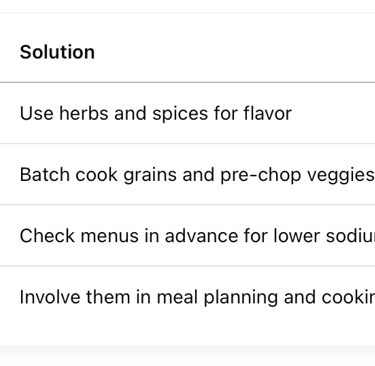
DASH Diet for High Blood Pressure – Final Thoughts
The DASH diet for high blood pressure is more than a short-term fix or a temporary eating plan—it’s a science-backed lifestyle shift that can transform your heart health, energy levels, and overall well-being. Designed by leading health researchers and supported by decades of clinical evidence, DASH addresses one of the most pressing health issues of our time: hypertension.
Whether you're newly diagnosed, at risk, or simply want to take a proactive role in your health, the DASH diet offers a practical and sustainable way forward. Its strength lies in its simplicity and flexibility—you’re not required to count every calorie, buy expensive ingredients, or eliminate entire food groups. Instead, it’s about making smarter, more intentional food choices each day that, over time, retrain your body and support your heart.
Most people who adopt the DASH diet begin to see tangible improvements in their blood pressure within just a few weeks—and those benefits only continue to build with consistency. But the impact goes even deeper: weight loss, improved cholesterol, better blood sugar control, reduced inflammation, and lower risk of stroke and heart disease are all within reach.
What makes DASH especially powerful is that it’s doable for real life. You can follow it at home, dine out without anxiety, and even include your whole family without major disruption. And because it’s not overly restrictive, it’s easier to maintain long term, turning healthy eating into a natural part of your lifestyle—not a constant battle.
So whether your goal is prevention, management, or total lifestyle transformation, the DASH diet delivers a proven roadmap to lower blood pressure and elevate your quality of life. It’s a long-term investment in your most valuable asset: your health. Start small, stay consistent, and trust the process—because a healthier heart starts with what’s on your plate.
References
U.S. National Heart, Lung, and Blood Institute (NHLBI). Your Guide to Lowering Your Blood Pressure With DASH.
Available at: https://www.nhlbi.nih.gov/education/dash-eating-planMayo Clinic Staff. DASH diet: Healthy eating to lower your blood pressure. Mayo Clinic.
Available at: https://www.mayoclinic.org/healthy-lifestyle/nutrition-and-healthy-eating/in-depth/dash-diet/art-20048456Sacks, F.M., et al. (2001). Effects on blood pressure of reduced dietary sodium and the Dietary Approaches to Stop Hypertension (DASH) diet. New England Journal of Medicine, 344(1), 3–10.
DOI: 10.1056/NEJM200101043440101Appel, L.J., et al. (1997). A Clinical Trial of the Effects of Dietary Patterns on Blood Pressure. New England Journal of Medicine, 336(16), 1117–1124.
DOI: 10.1056/NEJM199704173361601American Heart Association. Understanding Blood Pressure Readings.
Available at: https://www.heart.org/en/health-topics/high-blood-pressureCenters for Disease Control and Prevention (CDC). High Blood Pressure Facts.
Available at: https://www.cdc.gov/bloodpressure/facts.htmJohns Hopkins Medicine. DASH Diet: A Heart-Healthy Eating Plan.
Available at: https://www.hopkinsmedicine.org/health/wellness-and-prevention/dash-diet-a-hearthealthy-eating-plan



